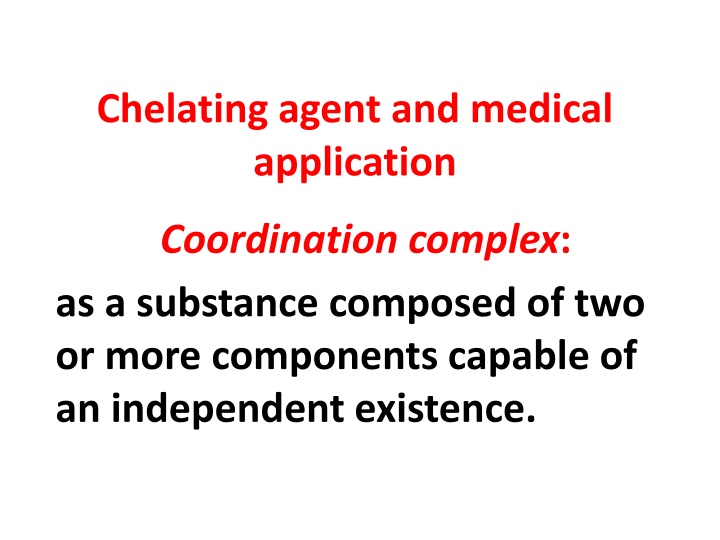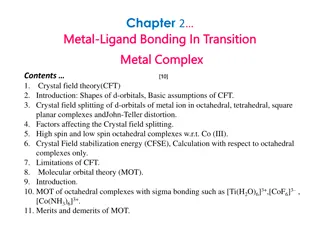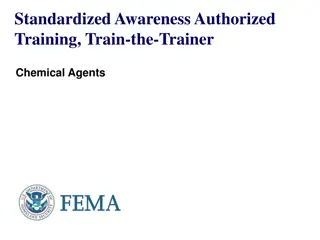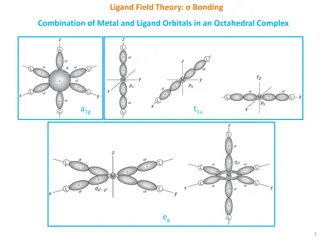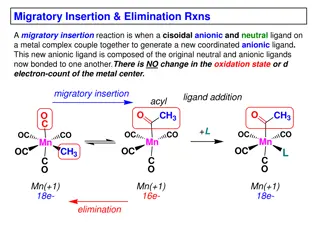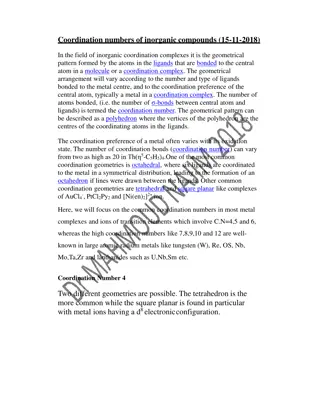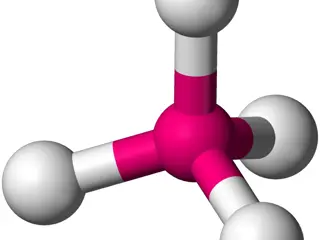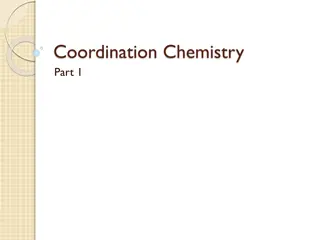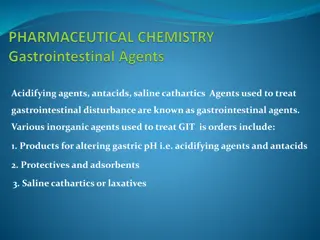Chelating Agents in Coordination Complexes
Chelating agents play a crucial role in forming coordination complexes, where a central atom or ion is bound to ligands through coordinate covalent bonds. These complexes involve the interaction between a Lewis acid central atom and Lewis base ligands to create a coordination sphere. The nature of metal-ligand bonding can vary from covalent to ionic bonds, impacting the stability and properties of the complex. Ligands such as ammonia act as electron-pair donors, binding to central metal atoms to form stable complexes with diverse applications in medical and chemical fields.
Download Presentation

Please find below an Image/Link to download the presentation.
The content on the website is provided AS IS for your information and personal use only. It may not be sold, licensed, or shared on other websites without obtaining consent from the author.If you encounter any issues during the download, it is possible that the publisher has removed the file from their server.
You are allowed to download the files provided on this website for personal or commercial use, subject to the condition that they are used lawfully. All files are the property of their respective owners.
The content on the website is provided AS IS for your information and personal use only. It may not be sold, licensed, or shared on other websites without obtaining consent from the author.
E N D
Presentation Transcript
Chelating agent and medical application Coordination complex: as a substance composed of two or more components capable of an independent existence.
coordination complex: Consist of a central atom or ion is joined to one or more ligands through what is called a coordinate covalent bond in which both of the bonding electrons are supplied by the ligand.
In such a complex the central atom acts as an electron-pair acceptor (Lewis acid) and the ligand as an electron-pair donor (Lewis base ). The central atom and the ligands coordinated to it constitute the coordination sphere.
Thus the salt [Co(NH3)5Cl]Cl2is composed of the complex ion [Co(NH3)5Cl]2+and two Cl ions; components within the square brackets are inside the coordination sphere, whereas the two chloride ions are situated outside the coordination sphere. These latter two ions could be replaced by other ions such as NO3 without otherwise materially changing the nature of the salt.
ligand : Is an ion or molecule that binds to a central metal atom to form a coordination complex . The bonding between metal and ligand generally involves formal donation of one or more of the ligand's electron pairs. The nature of metal-ligand bonding can range from covalent to ionic bond.
The nature of metal-ligand binding 1-Lewis acid base interaction. The ammonia ligand in {Ni(NH3)6}+2act as Lewis base(donor atom),and the metal cation serves as lewis acid (accepter atom).The bond between them forms by overlap of orbital on the metal cation with the orbital on the nitrogen atom that contain alone piar of electrons.
2-Electrostatic attraction force between the metal ion and the anionic or polar ligand.
Types of ligand: 1-monodentateLigands The ligands with one donor atom like ammonia is monodentate ligand with nitrogen donor atom. 2-bidentateligands The ligands that have two donor atom like ethylene diamineH2NCH2CH2NH2.
3-Tetradentate ligan Heme is a good example, the iron atom is at the center of a porphyrin bound to four nitrogen atoms of the macrocycle. 4-Hexadentate Ethylenediaminetetracetate(EDTA).It has a six donor atom ,all of which can bond to single metal ion.
chelating agent Organic chemicals that form coordination bonds with a central metal ion, used to chemically remove ions from solutions, against microorganisms, to treat metal poisoning and in chemotherapy protocols. .
Important of chelating ligands: 1-Used in the determination of some mineral in the urine and blood like Mg and Ca by using EDTA. 2-Chelation therapy, simply defined, is the process by which a molecule encircles and binds (attaches) to the metal and removes it from tissue. Depending on the drug used, chelating agents
Characteristics of chelation therapy: 1-Greater Affinity, Low Toxicity 2-Ability to compete with natural chelators 3-Ability to penetrate cell membranes 4-Rapid elimination of the toxic metal 5-High water solubility 6-Capacity to form non-toxic complexes 7-Same distribution as the metal
A-Matel toxicity: For example lead poisoning ,which is effect the central nervous system,and cause brain damage in the children . The mono calciumdisodium salt of EDTA is used in the treatment of lead poisoning rather than one of the sodium salt of EDTA because the addition of calcium with the chelating agent avoids problems of calcium ion depletion.
b-Chelating agents in the treatment of cancer: There are relationship between chelation and cancer because some of the coordination complex of platinum are very effective inhibitor for the growth of tumors .Most chemotherapeutic agent effective against cancer are chelating agent ,for example 2,2bipyridyl and 1,10-phenanthrolin are known to possess anti-tumor activity.
Chelation can be accomplished with nutrients that protect our bodies from heavy metals. 1-Magnesium protects us from aluminum 2-Amino acids, calcium, iodine, selenium, vitamin C, and zinc protest us from arsenic. 3-Amino acids, calcium, vitamin C and zinc protect us from cadmium. 4-Amino acids, calcium, iron, Vitamin C, vitamin E, and zinc protect us from lead. 5-Amino acids, selenium, and vitamin C protect us from mercury 6-Vitamin C, molybdenum and sulfur-containing amino acids(cysteine) chelate copper.
